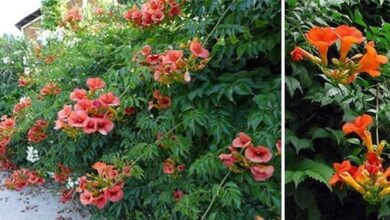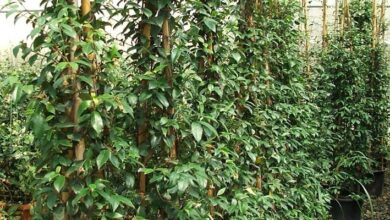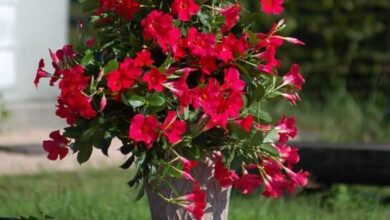Celestina, climbing plant with blue flowers


The matchstick is a very striking plant due to the color of its flowers. But although it is usually known by the name of matchmaker, it has many synonyms by which it is known. The most common Latin name for the most common species is Plumbago auriculata, a rather rare or unpleasant name for the appearance of this perennial plant.
You can call it by whatever name you want, but it is possible that if when looking for the plant on the internet by any of these names, you will most likely find the plant whose flowers are red or white. Do not worry, then you will know them.
Origin of the Celestina plant

For sure we can not say exactly what the origin of the Celestina or jasmine az u l. The reason is simple, since everything depends on the type of Celestina that is being spoken, such as:
Plumbago auriculata
This species has its origin in the South African continent. Of all the subspecies that belong to the celestine, this is the one that is most commercialized throughout the world, since it is very easy to cultivate.
Plumbago rosea
Unlike the previous one, the origin of this matchstick belongs to the Asian continent. So its natural habitat is there. The main strength of this plant is its flowering.
But the color of its flowers makes it worth having in any garden. Both its flowers and its leaves are different from the previous one. Well, it has a red flower and its leaves are less long and tend to have an oval shape.
European plumbago
Don’t let its name confuse you, since this plant can practically be found anywhere that is dry, open and, above all, in vacant lots. In addition to being known as European Plumbago, it is also called belesa or dentelaria.
characteristics
The matchstick is a beautiful and striking climbing plant because it is one of those plants that spreads quickly, but unlike others of its species, it is distinguished by its small light blue flowers that, during the flowering season, form an intense coat that is pleasing to the eye.
In addition, it has the virtue of being a plant that does not always have to rest on a wall or surface, but can grow in isolation and thus function as a living fence. So it is very common to see this and many other varieties of celestine in gardens, since its main use is oriented to the ornamental.
Celestine is a great plant to have in the garden, as unlike other specimens, it blooms all year round except in the coldest winter months. The flowers stand out among the whitish scaly leaves, woody stems, and arched, hanging branches.
It should be noted at this point that the characteristics of the matchmaker are not general. As could be seen in the previous section, there are three different species that share the same common name, so it is correct to talk about the specific characteristics of each of them.
Characteristics of the Plumbago auriculata
Although it is known as celestine, the scientific name of this plant is Plumbago auriculata. However, it is also popularly known as Blue Jasmine, Plumbago, Cape Jasmine, Sky Jasmine, Celestinas, Blue Jasmine, Azulina or Celestial Jasmine.
Its sky blue flowers are characteristic, which have a cylindrical morphology and five petals. Although they are usually this color, there is a variety whose flowers are white.
Characteristics of the Plumbago indica
The main characteristic is that its flowering is not as abundant as the conventional matchstick. But if it has a different color and quite striking and vibrant. The color of its flowers is red, while its leaves tend to be a little lighter green.
As for the flowering time, it is located between the months of July and December. So he spends five whole months creating new flowers. In order to cultivate this species in space, it is necessary to consider an environment whose temperature is not so hot and above all, that does not drop below 7 ° C.
Characteristics of the European Plumbago
As already mentioned, the European prefers wastelands and dry places. It adapts very well to these environments. Unlike the previous ones, the plant has a dark green color, its stem tends to be a little angular and has a woody texture.
The leaves can be up to 9 cm long. As for its flowers, they are grouped in the form of inflorescence and at the same time, in the form of a spike.
It should be noted that they have a tubular calyx, although it still has the characteristics of a bush, it is not as large or leafy as the previous ones, but it gives a good view to any garden that has dry land.
Care

The best time to sow the plant is winter and spring. It needs to be in full sun, although it grows without problems in semi-shady places, its flowering being affected in these cases. In very hot climates, it is best not to receive direct light.
On the other hand, it does not support frost, so it must be protected in places with winters of -5 degrees Celsius. The ideal soil for this plant is one that is sandy and with good drainage, and a fertilizer is recommended every week if it is grown in a pot.
Irrigation should be abundant in summer and moderate in winter, being a plant that needs annual pruning to control its growth. It may also need the support of stakes due to the nature of its branches.
Culture
Like any other plant that is intended for gardens or cultivation in general, they have some techniques or requirements that you must follow and know. The main aspects to consider are:
- Keep them in temperate places or where the environment is not less than 7 or 10 ° C. It is preferable to have them in hot environments.
- It needs to be in a place where it gets a lot of sunlight. So it is a plant that has to be directly under the sun.
- It is necessary to avoid at all costs that the wind blows very strong drafts.
- It is recommended to have some stakes to control the growth of the plant.
In addition to this, it requires some extra requirements to give the plant the life it deserves in your garden, such as:
Irrigation
It is not surprising that the plant needs a large amount of water since it is not a plant of dry environments. Otherwise it would dry out due to the lack of this element.
So, during the summer and spring, is when you have to give it a lot more watering, yes, you have to do it once you notice that the earth around it has completely dried up.
But try as much as possible to avoid waterlogging, you can cause its roots to rot or the plant to acquire some disease. Of course, when you go to water it, do not do it when the sun is nourishing it with its light, preferably during the afternoon or first thing in the morning.
Soil
It does not require many things to adapt to the ground, only a place where the water can drain without problems and there are no puddles. On the other hand, if you want to have the matchstick in a pot, it is advisable to add one or two handfuls of gravel or expanded clay balls.
This will make it easier for the water to drain and prevent the roots from rotting from too much water. In case you intend to transplant it to another place or have it directly in the ground, it is best to do it while it is in spring.
Compost
The fertilizer that you will be giving to the plant will vary depending on the time of year in which you are. For example, if you are in spring, you have to add compost every two weeks. On the other hand, and when you are in the middle of summer, the fertilizer has to be constant.
As for autumn or winter, depending on where you are, the subscription must be suspended. Some think that it does not matter, but it is essential not to give these nutrients for these times of the year.
Common pests and diseases
The pests and/ or diseases that affect the Plumbago auriculata affect its physical appearance most of all. It can even kill the plant if it is not treated in time.
Among the most common problems of this plant are:
- Wilted leaves due to poor watering . Whether it is watered a lot or a little.
- Extreme cold can dry out the plant quickly. All you have to do is remove the damaged parts and move it to a warmer place.
- The flowers do not grow because of being in a soil poor in nutrients, or lack of fertilizer.
- Aphids are the pests that most afflict this species. You should inquire a little more or ask a botanical business about what specific product you have to use.
Applications

It is not surprising that this plant is an abundant species in the gardens, but this does not mean that it has too many uses. The only use that is known at the moment is ornamental.
The rest have no beneficial use, but the simple fact of having this shrub in your garden makes it worthwhile to offer the care it needs.




